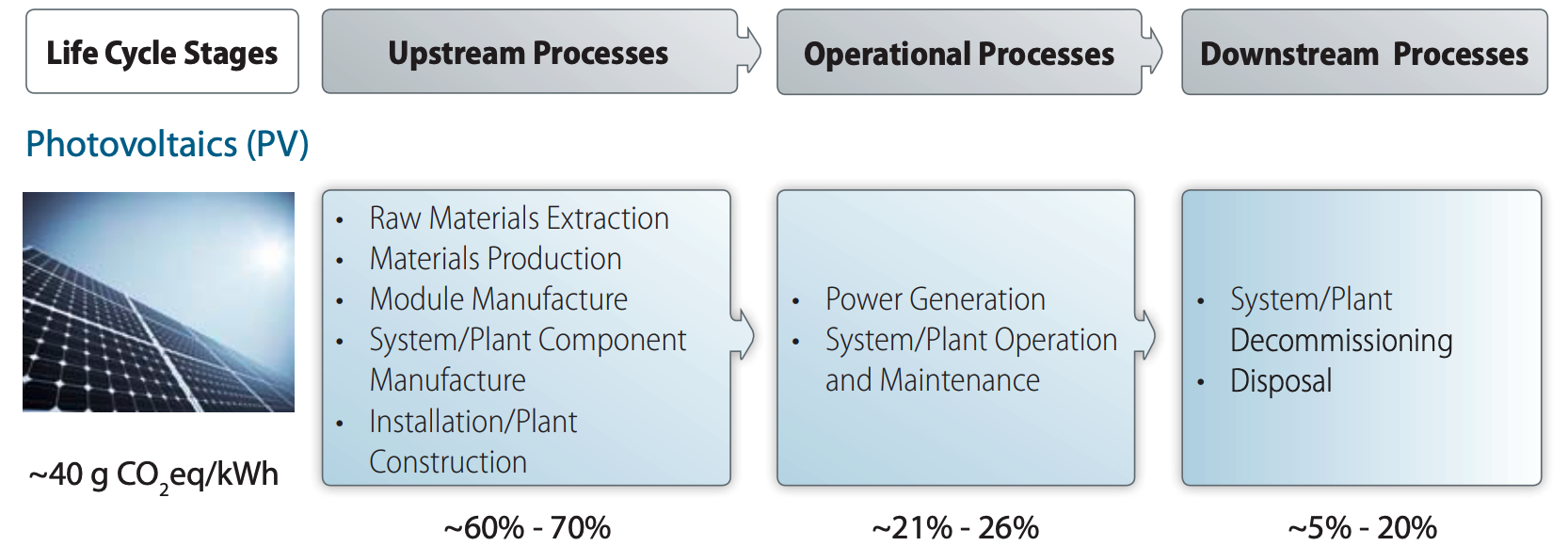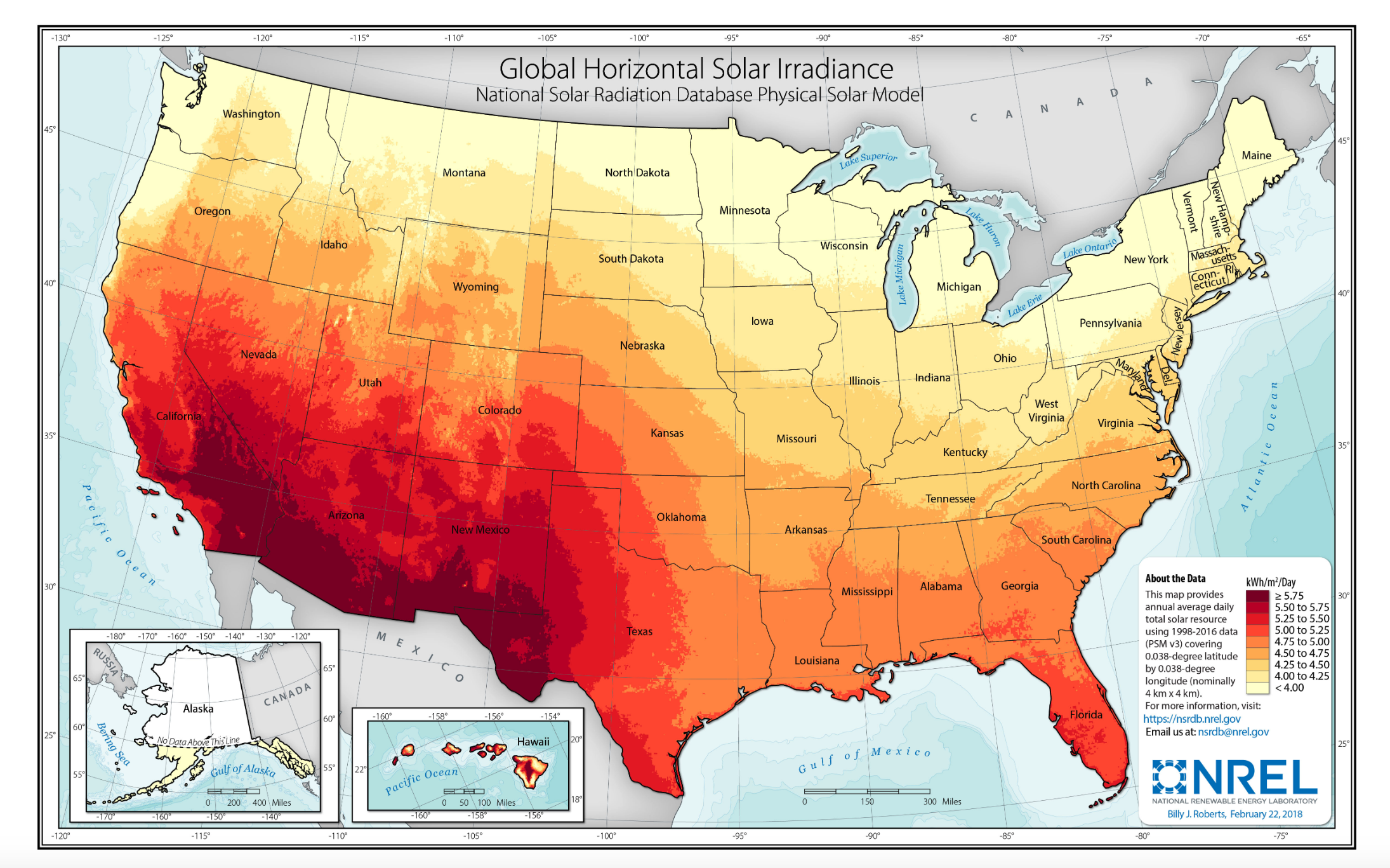Although the direct emissions (i.e., scope 1 emissions) from solar panels are zero, there are emissions generated upstream and downstream from the use of solar panels. In scope 3 category 3 (FERA: Fuel- and energy-related activites), we account for the upstream emissions from solar panels.
Solar electric: Upstream, operational, and downstream life cycle stages of solar photovoltaics
Source: NREL 2012
There are two main questions to consider when deciding which upstream solar emissions factor makes sense for you:
- What kind of solar panels do you have?
- Where are you located (and therefore what is your solar irradiance level)?
There are 3 common types of solar panels:
- Crystalline silicon. This is the most common kind of solar panel, and it is commonly used on building rooftops and in ground-mounted racks for large systems.
- Thin film. This lightweight and flexible type of panel has a range of applications.
- Concentrated solar power (CSP). These less common systems use mirrors to concentrate sunlight into a receiver.
There are two main categories for irradiance levels:
- High solar irradiation: About 2400 kWh/m2/year or an annual daily average of >5.5 kwh/m2/day (in areas with lots of sunshine, such as the Southwest US)
- Low solar irradiation: About 1700 kWh/m2/year or an annual daily average of <5.5 kwh/m2/day (everywhere else)
Use this map of US solar irradiance levels to determine whether you are in a location with high or low solar irradiation.
Source: NREL 2018
In SIMAP, we default to a weighted average upstream emissions factor
The SIMAP default emissions factor uses the following assumptions:
- Solar panel type: Crystalline silicon and thin film weighted average. CSP was excluded because it is not very common.
- Solar irradiation level: Average of high and low solar irradiation levels
What does this get us to? A default emissions factor of 0.0222 kg CO2e/kWh
If you have more information about your type of solar panels and your solar irradiation level, then you can customize this upstream emissions factor. Read one for more details.
Upstream Emission Intensities for Solar PVs at Low and High Solar Irradiation Levels
The table below shows scope 3 upstream emissions factors for solar panels. The emissions factors are organized by type (crystalline silicon and thin-film) and solar irradiation level (low and high). If you know what type of solar panels you have, you can select the appropriate emissions factor from the table below and enter that custom factor into your SIMAP account.
Upstream scope 3 emissions factors for solar panels by type and solar irradiance level
|
Solar PV types
|
Low Solar Irradiation kg CO2e/kWh |
High Solar Irradiation kg CO2e/kWh |
||||
|
Solar Energy Source |
Known |
Crystalline Silicon |
If unknown use weighted average |
0.02925 |
0.0208 |
|
|
Known |
mono-Si |
0.026 |
0.01849 |
|||
|
multi-Si |
0.03055 |
0.02172 |
||||
|
Thin-Film |
If unknown use weighted average |
0.01344 |
0.00942 |
|||
|
Known |
a-Si |
0.01853 |
0.01333 |
|||
|
CdTe |
0.013 |
0.00910 |
||||
|
CIGS |
0.02438 |
0.01723 |
||||
|
If unknown use weighted average |
0.0253 |
0.01913 |
||||
Note: Upstream emissions are 65% of the total lifecycle emissions from solar panels. The balance is made up from the operation of the panels (23% of total emissions) and the downstream disposal (12% of total emissions).
How to enter your custom solar emissions factor into SIMAP
You can customize your upstream solar electric emission factors using the following steps:
- Go to the Data Entry tab > Emission factors page
- From the drop-downs, make the following selections: Scope 1 > On-campus stationary sources > Solar - electric
- Now when you select the last drop-down, FERA emission factors will appear for all emission factor types
- Select the 'FERA CO2' emissions factor, enter your custom emissions factor in the text field for all applicable years, and click the green 'save' button at the end. Note: If using the emissions factors above, you should ONLY enter a factor in the CO2 field because the units are CO2-equivalents. The N2O and CH4 fields were intentionally left blank for solar - electric to avoid double-counting.
Which solar - electric FERA emissions factors are available in SIMAP?
The upstream emissions factors for solar electric in SIMAP are only available in CO2-equivalents because that is the unit provided in the data source. Because we could not split this normalized emissions factor into specific greenhoues gases (CH4, N2O), we entered the CO2-equivalent emissions factor as the CO2 factor and left the CH4 and N2O factors blank to avoid double-counting. The same CO2-equivalent emissions factors are used across all years.
Although NOx emissions are generated from upstream solar - electric, we do not yet have those emissions factors calculated and populated in SIMAP. If you have a custom upstream solar elecric emissions factor for NOx, there is a blank field on the emissions factors page where you can enter your custom factor.
Sources
Hsu et al. 2012. Life Cycle Greenhouse Gas Emissions of Crystalline Silicon Photovoltaic Electricity Generation. Journal of Industrial Ecology. https://doi.org/10.1111/j.1530-9290.2011.00439.x
NREL 2012. Life Cycle Greenhouse Gas Emissions from Solar Photovoltaics. https://www.nrel.gov/docs/fy13osti/56487.pdf
NREL 2012. Life Cycle Greenhouse Gas Emissions from Concentrating Solar Power. https://www.nrel.gov/docs/fy13osti/56416.pdf
NREL 2022. Solar photovoltaic technology basics. https://www.nrel.gov/research/re-photovoltaics.html



